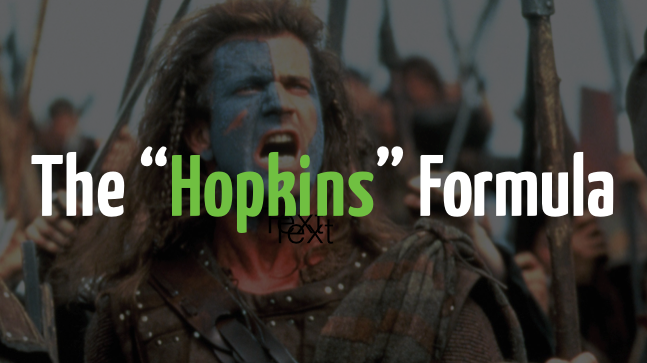
Last weekend I read Scientific Advertising by Claude Hopkins and it was obvious after reading the first chapter that Claude was one of the most brilliant marketers ever.
Even though the book was written nearly 100 years, I became more and more entranced after every page.
One chapter was so brazen, so different, that it hit me like a …

In that chapter he described a sales strategy that immediately captivated me.
This sales process converted 90% of his prospects into customers.
NINETY PERCENT!
The strange part was that no one uses it anymore. It worked insanely well 100 years ago, but it has been completely forgotten.
Not anymore!
Today you will learn:
- Claude Hopkins’ exact sales strategy
- How Michael Hyatt, my local CrossFit gym and Videofruit can use the strategy
- A real life implementation of this with the best blog post bonus ever
***
The Strategy and how Claude used it
Want to know what the strategy is?
He gave his product away for free.
I’m not talking about free eBooks or iPhone apps either.
He gave away typewriters and washing machines. Big stuff that was hard to ship.
Here it is in his own words:
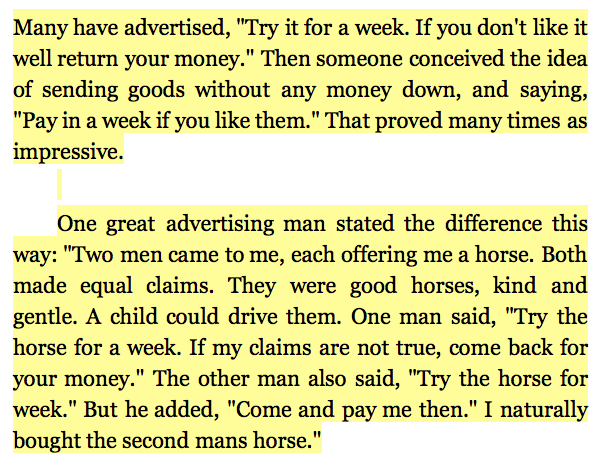
and…
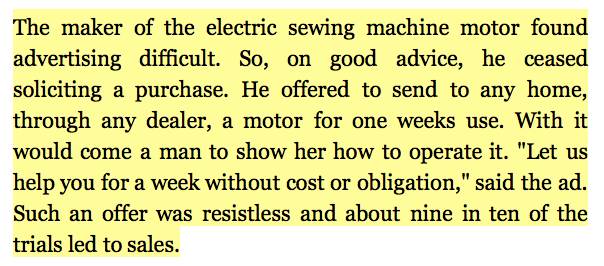
(Note: If you want the rest of my notes and highlights from the book, grab them in the bonus section at the end.)
In short: His sales strategy was to give his customers his product for free. No credit card details or payment upfront and no limited functionality. Just free.
Need a sewing machine? Here is one.
Need a washing machine? I’ll ship it to you.
If they didn’t like it, they could send it back after their week was up.
But if they did, they would keep it and pay the regular sales price.
…and nine of of ten people kept the item and paid for it.
Why did this work so well?
This strategy works so well because it debunks your #1 objection to buying anything.
That objection is the same thing that keeps you from spending $100 at a new steak house or from taking the $2,000 trip to Costa Rica that you’ve always dreamed about.
That thing is fear.
Fear that the food wont be worth it.
Feat the the trip won’t be worth it.
Fear that you’ll spend the money to buy that expensive thing and then the product will under deliver.
Because if that happens, you look dumb.
Your friends make fun of you and you become “that guy.”
BUT WHAT IF…
The steak was free.
The trip was free.
And you only had to pay if you enjoyed it.
What would you do it then?
You would book the trip TODAY.
By being offered that initial experience with no risk you are allowed to experience the product without fear.
Once you step foot in the restaurant and you taste the steak for the first time, everything changes. It is no longer this theoretical place. It is a real life experience that you can tangibly grasp and understand.
Fear is gone and without fear the buying process become easy.
The strategy works because it completely obliterates the first obstacle of every sale.
How Michael Hyatt, my local CrossFit gym and Videofruit can use the strategy
How would this look today?
Most of you reading this don’t sell washing machines and typewriters. We sell digital products.
So, let’s look at 3 specific examples of how this could play out.
Example #1: Michael Hyatt
Take Michael Hyatt’s Platform University as an example.
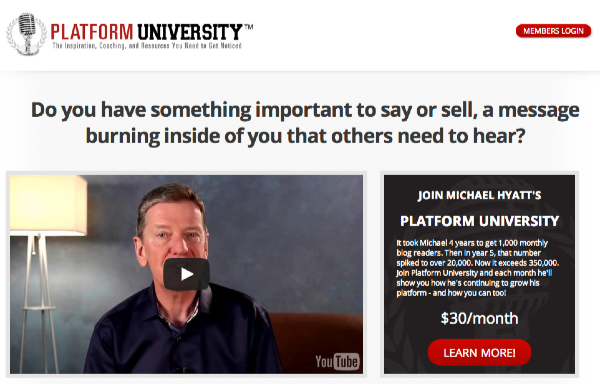
Normally enrollment in this class is $30 per month and new students are accepted 3-4 times per year.
While new students are not being accepted he sets up a waiting list for anyone that wants to start the class.
Then, when open enrollment begins everyone is sent a series of emails to get them to buy.
This model works well.
But the Hopkins Formula could supercharge it.
Here is how.
The problem with a traditional waiting list approach is that several months can go by between the time you sign up and pay.
This gives you plenty of time to talk yourself out of joining and fear enters the equation.
Enter the Hopkins Formula
What if Michael did this?
Instead of sending a series of emails to warm the list back up, send this email.
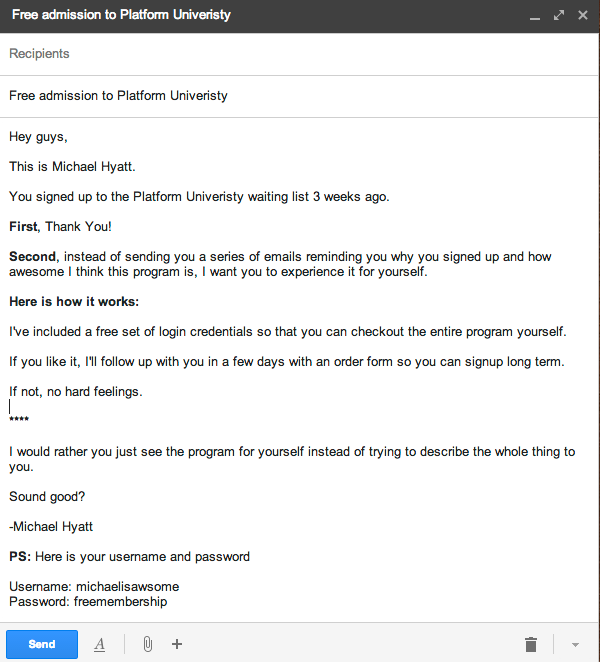
Which method do you think would convert more people?
Method 1: 3-5 emails reminding me why I signed up. Then asking me to buy while giving a 30-day money back guarantee
OR
Method 2: Unexpectedly giving me a free membership. Only asking me to pay if I like it.
Which one eliminates fear most effectively?
Example #2: Nashville CrossFit
I’ve been wanting to start Crossfit for months.
But it costs $125 per month AND there is a minimum of a 3 month signup.
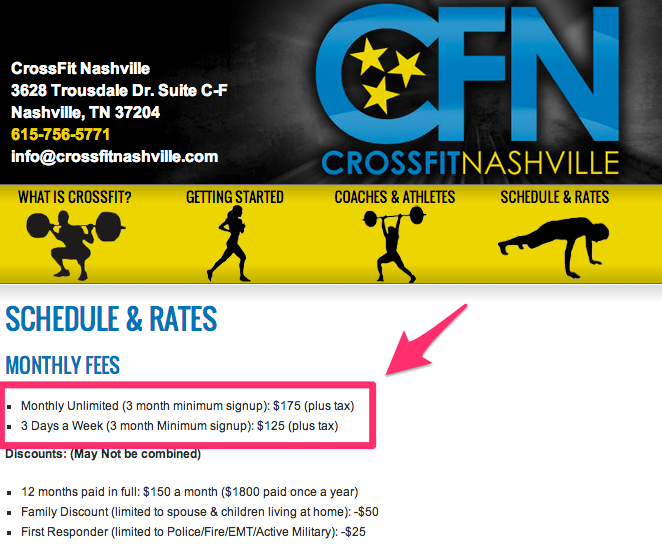
These are the thoughts that have been going through my head and preventing me from starting:
- “What if I don’t stick with it?”
- “That’s a decent chunk of cash to throw away”
- “What if I can’t hang with these guys”
- “What if life just gets busy”
- “I sure wish I could just try it out first”
And they do nothing to appease these fears.
$125 a month for 3 months or NOTHING.
UGH!
I might eventually talk myself into it, but after 3 months of thinking about it I haven’t yet.
How could they fix this?
Very easily.
All they need to do is prominently advertise a free intro class.
Because the second I get up off of my butt and walk in their doors all of those questions are eliminated.
A combination of Optinmonster & Mailchimp would produce a simple pop that allows people like me to book a free intro class.
No “3 month commitment”, just one class and I don’t have to pay until I’ve experienced the product.
#lowhangingfruit
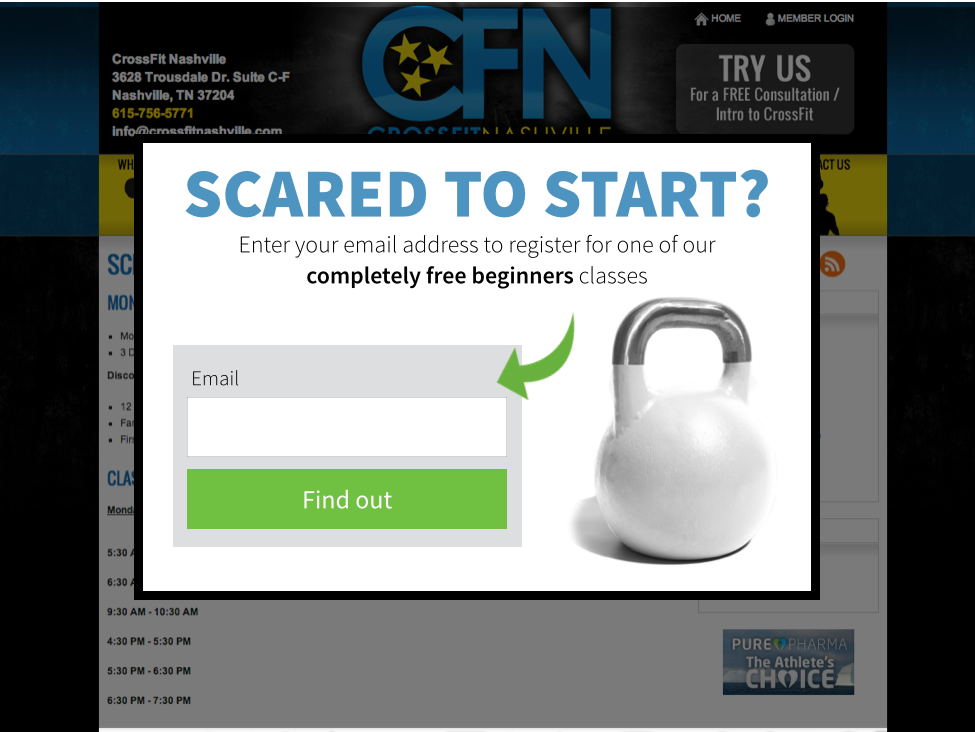
Example #3: Videofruit
Now to Videofruit.
It’s easy to look at other people and point out things they could do better, but it’s painful to look at yourself.
There are 2 things I could do to implement the Hopkins Formula with my paid course.
Thing 1: Offer 7-days of free access to anyone who completes my free course.
To access my paid course you have to first go through a free version of the course.
The free course includes an hour’s worth of training and multiple free downloads to help you learn to make cool explainer videos.
Then after the free course I upsell you on a $397 paid version.
By giving the free content first, some fears are reduced. However, $397 is still a big price tag and the #1 fear that my students have expressed has been “Is it worth it?”
How could I solve that?
Automatically give them access to the paid course when they finish the free course.
So, instead of sending out a series of 10 emails that ends with a sales letter to buy, what if I sent this email instead?
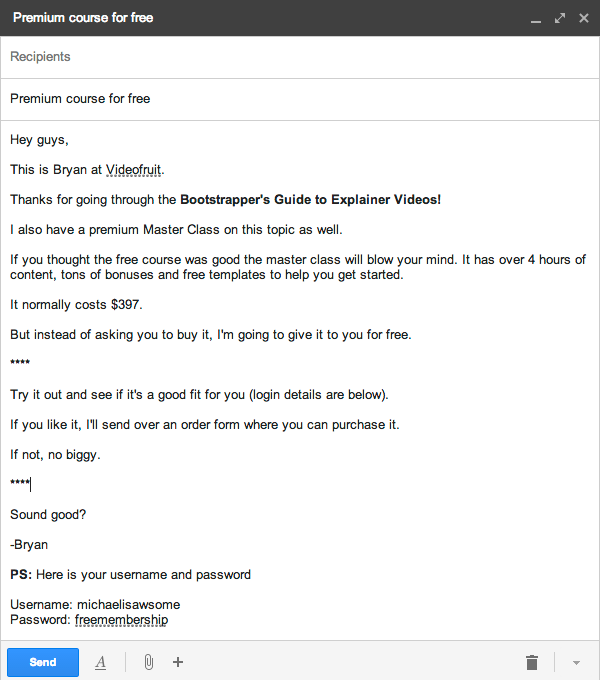
Thing 2: Spontaneously give away my course
What if once a year I opened up free access to the entire course?
“Try it. If you like it, buy it.”
There are three big benefits I see:
- It allows my readers to see what my paid content looks like
- Gives me a massive influx of feedback and suggestions
- Who doesn’t like getting free stuff?
But, but, but…BRYANNN!
What if they just take off with it?
First of all, do you sell typewriters? No.
We sell digital goods. apps, books and courses.
Even if someone was able to steal your product, which you can guard against, your cost per goods sold is extremely low and losses and very minimal.
What’s the worse case scenario?
The worse case would be that someone see’s your premium content, uses it and never pays you. Then after a week their access to that product goes away.
So what?
Did you lose any money? Nope.
If their only intention was to rip off and copy all of your content to their hard drive then two things apply.
- They were NEVER going to buy from you anyway
- They have a ton of free time on their hands, which means (see #1 again)
PS: How can you use the Hopkins formula in your business? I’m very curious to see how you guys implement this strategy and would love to hear more about it. Leave a comment below.